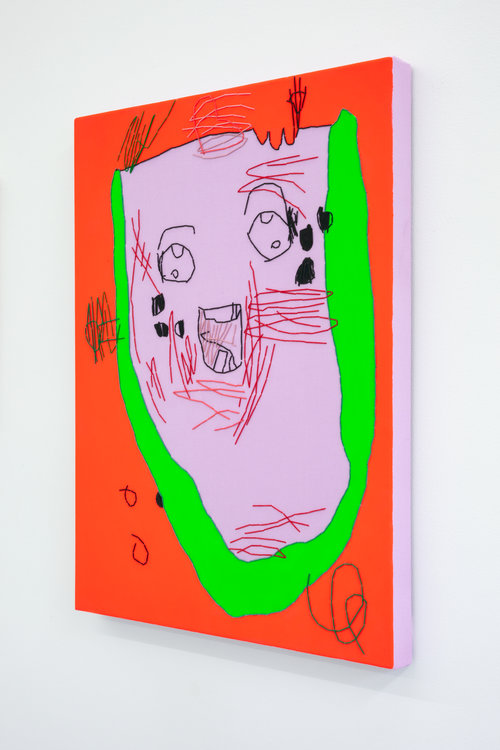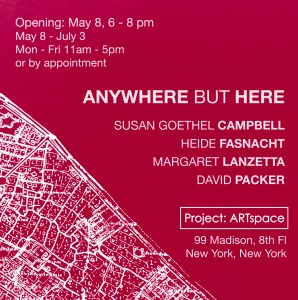
Contributed by Jennifer Coates / I met Caroline Wells Chandler when he was an MFA student at Yale, and we immediately connected in a lunatic mind-meld way. Together, our imaginations sparked, and last year we collaborated on �Electric Mayhem,� a two-person exhibition at Crush Curatorial inspired by the band on The Muppet Show. For his current solo at Mrs., on view through June 1, Caroline has developed a completely new approach from his critically-acclaimed crocheted figures. We talked about his new work, which is even weirder and edgier than the radical earlier stuff.

Jennifer Coates: Is there an isomorphic continuum between glue, bing bong and Snooki?
Caroline Chandler: Haha. I don�t know! They are all archetypes that I have inhabited at some point in my timeline. If you have a theory on that I would love to hear it.
JC: Glue is any fluid adhesive. Bing Bong is comprised of a cat, elephant, and dolphin (with a body made of pink cotton candy). According to her Wikipedia page, Snooki is a reality television star, television host, author, professional wrestler and dancer. In looking for connections I would say that, as subjects for your artworks, they all have magical properties; they are attractors. The glue holds objects in place, Bing Bong is conscious candy in the form of a cross-species animal hybrid, and Snooki is a shape-shifting performer who is in command of many ways of keeping our attention. They all have the power to unite unlikely elements together into one hyper present entity. The reason I am asking is because it seems like your choice of subject isn�t random. You say they are all archetypes you�ve inhabited. Can you say a little more about that?
CC: I�ve left no stone unturned in discovering who I am. I�m a bit of a method learner. Regardless of whether a person is represented by the mainstream or not because they belong to a marginalized group, it is fundamental to the human experience to want to see yourself reflected as an icon. Icons are consciousness expanding vehicles to experience the fullness of the self or selves by allowing the journeyer to transcend one�s solipsism. As a trans person my drag net and roving third eye yields non-suspect results.

JC: How do you reconcile color choices in your recent work, is it through a spirit guide?
CC: I really like bright color. Bold color makes me feel happy and awake. A close friend of mine from summer camp was from and lived in Guadalajara, Mexico. The summer before I completed my foundation studies at RISD, I stayed with her family and studied Spanish. I think that really shaped my color sensibilities. I also looked at and was influenced by a lot of Caribbean and Latin American art when I was in high school. I think that has had the most influence on my color sensibilities, other than Esmeralda. Esmeralda is the spirit guide that helped us find our apartment when we moved to Queens. I also have an intergalactic insane clown posse that lives in another realm. They protect me from people who wear too much Khaki.

JC: Does this clown posse appear in your work? For instance the clown-like smiley faces that you use in your crochet work, are they an invocation of your intergalactic friends?
CC: I grew up in a conservative Southern Christian household. My mom was my soccer coach and my Sunday school teacher which should be illegal. We only had seven tv channels. My partner who grew up in a remote village in Lebanon had more exposure to American pop culture than I did. The first music video I saw was at a family friend�s home who had MTV. At age nine, Black Hole Sunby Sound Garden really warped my brain.
That was the first time that the clowns tried to make contact. My works are not portraits of my ICP but I do brainstorm with them to co-create a better reality. Are you down to clown?
JC: Can you talk a little bit about the different ways you work, the different mediums and processes and their interconnections?
CC: My goal this summer is to walk for an hour everyday to exercise my heart. I live a sedentary life as a labor intensive maker. I like to walk in the cemetery because it gives me a broader perspective. Sometimes I encounter territorial geese. Their poop and skittish behavior keeps me on my toes. The other day it was windy and a small black trash bag flew out from behind a tomb stone in my general direction like an evil ghost. The wind had it secretly lodged on the other side of the grave marker. When the pattern of the wind shifted, I screamed like a little girl.
If known for anything at all, it is probably for my hand crocheted figurative work. I�ve never considered myself to be the kind of artist who will make the same thing forever one way. I will always have a mad scientist lab folded within what I do and secret work. I was raised to be a Southern Belle and I see most of my work to be a queer subversion of that upbringing. It�s not lost on me that my primary ways of making consist of crochet, embroidery, and cake decorating which are all markers of the kind of woman I never became. Scientists have done tests on butterflies to determine if they remember their caterpillar state and the results point to yes. I�m no different. This flower done wilted and blossomed into Bobby Hill.
The intaglio prints in the show at Mrs. are my earliest works. I worked on them from ages nineteen to twenty one. They were made in an attempt to regain a pre-cultural drawing hand. I was really influenced by Jean Dubuffet�s Anticultural Positions essay which celebrated and defended work made by children, non-western artists, and artists with disabilities. When I made those prints I was looking at a lot of children’s work and studying it. I consider most of my work to exist under the larger umbrella of reductive figuration and the prints were my first attempt to explore that mode of making. Everything I have ever made stems out out of those works. At the opposite end of the spectrum are the collaborative drawings. I view collaborative drawings as something powerfully fringe. Collaborative drawing is an opportunity to get outside of one’s conventions and work with others to solve a common vision.

Teaching is also an extension of my studio practice. I naively got into art because I wanted to change culture. I am dubious that art is able to effectively make those changes in art fair booths, but I do believe in shows. In even a more profound way, I believe radical changes can be made in the classroom. Ive been making queer arenas for the past three years. I realized that I can do what I want my work to do in an incredibly direct way by being a queer mentor in the classroom. We would have never been friends if David Humphrey, your husband, had not been my teacher. Pied pipers of weirdness, like David, and full spectrum strobe light beacons of hope like yourself are the good vibrations and guiding lights to help the displaced changeling children plucked from their time and space continuums find a home in this not so fairy land. Teachers are critical for weirdos to find their place.
JC: Are fake cakes paintings?
CC: On 4/20 Manal needed a footrest when we were watching Ramy. I had a left over cake and I thought it would be really comfy because the foam is extra squishy and soft. And as you know I sent it to friends because you received these three pics.

Actually, your cake sculpture of Marie Antoinette looking fly in her cotton candy wig that you made with Juli Raja for the bake-off at Will Cotton�s studio inspired me. If you hadn�t sent me process shots from the day before and post-enjoyment beheading photos I would not have thought of this better living design solution! We described the cakes in the press release as trump l�oeil reliefs.


Cookies were the gateway for the cakes. A big part of crafting my vision involves mining early childhood experiences and memory to make idiosyncratic art. I realized that one of my first experiences painting was icing cookies with my Dad. I have contextualized the cakes as paintings in the past. While I think of everything in the show as a drawing, the works simultaneously are exploring in-betweenness.

JC: Did you feel like you were collaborating with another version of yourself when you made the stitched pieces?
CC: Some of these works are collaborative namely Manal�s Portrait of Me as Gertrude Stein, Our Red Studio, and Beavus and Butthead in Love. All of these started with a napkin drawing made by Manal. I love her hand because she draws like a whacky third grader. So basically Manal draws like Milton Avery.
I went back to the embroidered drawings because I wanted to start playing with rectangles again. I know that you consider looking back through the strata of one�s making to be a form of collaboration so I guess in that sense, yes-they are.

The embroidered drawings initially entered my stratosphere in my early 20�s after undergrad when I lived in Tyler, Texas next door to my grandparents. I had developed severe allergies to solvents. Our print studio at SMU was very toxic. We cleaned our plates in kerosene soaked saw dust. Hanging out in there compounded with all of the other poor health and safety decisions I made when I worked in oil and a wide range of toxic materials pushed me into exploring fibers. Drawing with the thread reminded me of the same way I worked an intaglio plate and the way it looked felt like I was making a reverse intaglio. I applied with sewn drawings to grad school. Utopia Topiaries the big yellow rainbow piece in the show was in my grad school application. I feel like I�ve been learning a lot about color and form over the past few years with my crocheted works and I wanted to apply that knowledge through a different medium and explore another kind of hand. My favorite thing about these sewn drawings is that they cannot be understood digitally. They can only be understood irl

“Caroline Wells Chandler: Tutti Frutti,� Mrs., 60-40 56th Drive,
Maspeth, NY. Through June 1. Closing party June 1, 12 -2 pm.
Artist�s bio (from the gallery�s website): Caroline Wells Chandler (American, b. 1985) lives and works in Queens, NY. He received his BFA from Southern Methodist University (Dallas, TX) in 2007 and his MFA from Yale University in 2011 where he was awarded the Ralph Mayer Prize for proficiency in materials and techniques. From 2016-17 he was a recipient of the Sharpe Walentas Studio Program. Recent solo exhibitions presented at Union Gallery (London, England), Andrew Rafacz.
About the author: Jennifer Coates is a writer, musician, and artist whose last solo show was “Correspondences� at Freight and Volume Gallery, New York, NY, in 2018.
Related posts:
Caroline Wells Chandler and the in-between
Jennifer Coates: Lullabies for difficult times
Conversation: Jennifer Coates and EJ Hauser at PAFA














